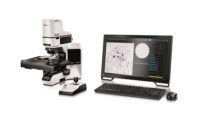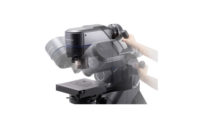Over the last 30-plus years, digital microscopy has gone through some very extensive improvements that affect the end user’s experience. Advanced yet user-friendly digital microscopy has revolutionized numerous industries and allowed users to complete inspection tasks more efficiently. Microscopes have been used for decades in industries for general inspection, quality control and R&D. The digital revolution in microscopy has extended the role of optical microscopes by creating new possibilities, such as image sharing, analysis, and measurement. They have paved the way for a sophisticated, user-friendly experience—especially for industrial use.
Digital microscopes have the advantage of being self-contained instruments with easy-to-use controls that are either built into the unit or into a remote control. Most advanced digital microscopes will feature built-in LED illumination, a snapshot/video recording function, and zoom/focus controls. These features eliminate the need to purchase extra accessories, such as external illumination products and additional microscope eyepieces.
Trinocular microscope systems give operators the option of viewing their inspection on a monitor or through the microscope eyepieces depending on what the application requires. Digital cameras transform microscopes into digital systems by incorporating progressive features. Some cameras have integrated monitors, which eliminates the need for an external monitor. The software that comes with many digital microscope products lets operators capture and save images with ease. Simple calibration also allows operators to make accurate measurements within the software. A split-screen view permits users to compare microphotography side-by-side. This comparison view lets users share live demonstrations for online meetings via webcam. Raw data can also be recorded and exported to a written report. Various color cameras and auto focus cameras also feature various adjustments such as exposure, white balance, brightness/contrast/sharpen, and freeze frame. Cutting-edge cameras come equipped with a USB flash drive and internal measurement software; this is another example of digital microscopy inspection eliminating the need for a computer.
While both traditional and digital microscopy remain valuable, on-screen inspection systems are in high demand, and for good reason. The most important benefit of digital microscopy has been in ergonomics, especially if microscopes are used for extended periods of time. Various digital inspection systems reduce eye strain and neck fatigue because there is no need to constantly look through eyepieces. Instead, these systems allow operators freedom of head movement so no muscles are strained and there are no faulty working positions. Compared to stereo microscopy, digital microscopy offers the following:
- Higher resolution captures a higher level of fine detail
- A larger field of view provides greater perspective
- Increased magnification range
- Color balance for accurate color pattern interpretation
- Real-time viewing with an HDMI signal and auto focus generate reduced lag time
To elaborate, the larger field of view from digital microscopy and increased working distance are crucial for efficient assembly and repair. Newer systems with auto focus capabilities allow for quick inspection at different heights and magnifications without adjustments. They also provide large depth of field for easier and more efficient work. With USB and HDMI interfaces and auto focus abilities, processing speeds have become so efficient that there is virtually no lag time between changes to the object being viewed and what is seen on the computer monitor.
Technological advances in digital microscopy have made sharing microphotography among multiple users much simpler. Images can be instantly magnified and in some cases auto focused for high resolution viewing on monitors for several individuals to inspect at once. Built-in features and cutting-edge software make it effortless to capture images, record video, and make measurements and annotations.
Microscope technology hasn’t just become vastly more powerful—it has also downsized—and USB and HDMI technology are the result of that miniaturization. Portable, handheld microscopes are powerful enough to be used in the field in combination with a laptop and don’t require the need for an external power source. Other inspection systems allow the user to connect the microscope directly to an HD monitor via the USB or HDMI outputs without the need of a computer.
Even with all their advantages, digital microscopes still need to overcome one major challenge—they are only capable of rendering 2D views of objects. With the right processing power and software, and sometimes with specialized glasses, it’s possible to get a sense of the depth and texture of an object. However, that sense of depth is nowhere near as detailed or accurate as a user with 20/20 vision can achieve using a traditional stereo microscope. Traditional eyepiece microscopy remains important, in part because of the cost factors involved in trying to render 3D views with digital microscopes. Integrated digital microscopy also lacks flexibility as camera technology rapidly changes. Simultaneously, new advancements in digital microscopy continue to revolutionize scientific and industrial inspection processes, making it easier for operators to view, measure, and share their work.
Digital microscopy technology has replaced traditional microscopy in some respects, however both methods remain vital in numerous industries today. While digital inspection systems reduce the eye strain and neck fatigue that stereo microscopy can cause, the 3D inspection perspective remains crucial. Digital microscopy is in high demand because of its convenience and ease-of-use—even for non-professional users—and operators can complete inspection tasks more efficiently than ever before. These advanced microscopy systems instantly magnify, auto focus, and produce high-definition images that can be viewed by multiple people simultaneously.




